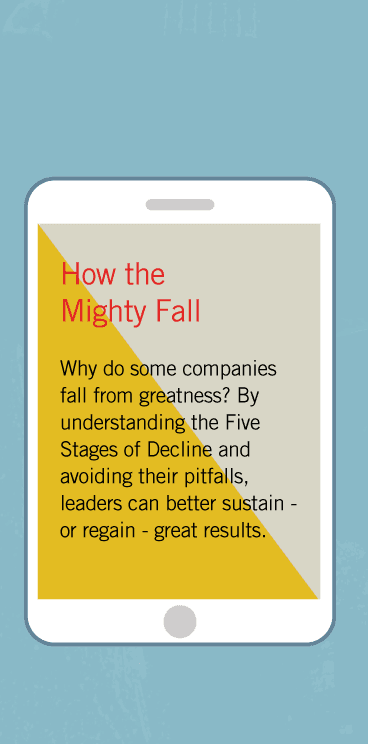Level 5 Leadership and 10X Entrepreneurial Success
Yet Miller showed nothing but gratitude, noting in 2000 that his life was dedicated to two things, Biomet and his family. “There’s nothing else I want to do in my life,” said Miller. “I enjoy virtually every day and I couldn’t be having any more fun or any more excitement about what I do.” As for being the most underpaid CEO relative to value, he blasted the idea of granting tons of upside-only options. What’s the point of just more and more and more for the sake of more and more and more? “What incremental value does an extra 100,000 shares have?” he snorted. “At some point, you’re just satisfying an uncontrollable greed complex.”
In Good to Great, we wrote about Level 5 leaders, those who lead with a powerful mixture of personal humility plus professional will. Every good-to-great transition in that research began with the emergence of a Level 5 leader who deflected attention from himself, maintained a low profile, and led with inspired standards rather than inspiring personality. On the surface, some of the 10Xers appear to be unlike Level 5 leaders. Kelleher had a zany and flamboyant personality who often drew attention to himself by his antics. So did Peter Lewis. In culling through decades of documents on the Lewis era at Progressive Insurance, we came across a range of descriptors: “Just plain strange.” “Oddball.” “A standard deviation from an iconoclast.” “A Wildman.” “Eccentric.” “A frame or two off the ordinary screen.” “A rock star without any musical ability.” “No way to jerk his chain because he doesn’t have one.” Lewis signed his annual letter to shareholders with the quirky “Joy, Love and Peace—Peter B. Lewis.” He strode into a board meeting one Halloween dressed as the Lone Ranger, firing cap pistols to the music of the William Tell Overture, an apt image given that Lewis began to see himself as the Masked Man. Lewis jumps off the pages of our research materials almost like a self-absorbed teenage male who inherits his family’s company and turns it into a hedonistic party house in some adolescent, fantasy, B-grade movie.
Yet despite his eccentricities and sometimes outlandish behavior, Lewis dedicated himself to one goal above all others, making Progressive a truly great company. And he built the company to be great without him. After Lewis engineered a smooth transition to his successor in 2000, Progressive continued to grow, gaining on its competitors, increasing share value, and sustaining a high return on equity. Did Lewis have a large personal ego and colorful personality? Yes. Did he mature, so that he eventually channeled his ego into building a company that could be great without him? Yes.
The 10Xers share Level 5 leaders’ most important trait: they’re incredibly ambitious, but their ambition is first and foremost for the cause, for the company, for the work, not themselves. Whereas Good to Great focused heavily on the humility aspect of Level 5 leaders, this work highlights their sheer ferocity of will.
Sometimes the 10Xers painted their causes in fairly grand terms, even while avoiding any sense of personal grandiosity. Gordon Moore, CEO of Intel from the mid-1970s to mid-1980s, maintained a low profile, despite being the primary company builder during Intel’s early growth. Moore nonetheless saw Intel’s purpose in gigantic terms, recognizing how microelectronics would revolutionize nearly every aspect of society. In 1973, only five years into Intel’s history, Moore said, “We are really the revolutionaries in the world today—not the kids with the long hair and beards who were wrecking the schools a few years ago.” Gordon Moore led with an understated personality, yet built a great company that would play a catalytic role in revolutionizing the way civilization works.
To focus on Gordon Moore’s understated personality, or Lewis’s and Kelleher’s outsized personalities, would miss the point. The central question is, “What are you in it for?” 10X leaders can be bland or colorful, uncharismatic or magnetic, understated or flamboyant, normal to the point of dull, or just flat-out weird—none of this really matters, as long as they’re passionately driven for a cause beyond themselves.
Every 10Xer we studied aimed for much more than just “becoming successful.” They didn’t define themselves by money. They didn’t define themselves by fame. They didn’t define themselves by power. They defined themselves by impact and contribution and purpose.






